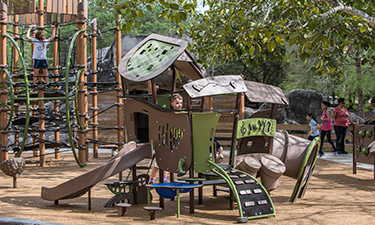 During the 1970s, the director for what was then the Metro-Dade Park and Recreation Department envisioned Amelia Earhart Park as an ideal location for a farm village where children could go to connect with nature and learn about animals. Nearby the farm village is a lake with a man-made island that the director wanted to turn into a “play-in-the-woods” experience.
During the 1970s, the director for what was then the Metro-Dade Park and Recreation Department envisioned Amelia Earhart Park as an ideal location for a farm village where children could go to connect with nature and learn about animals. Nearby the farm village is a lake with a man-made island that the director wanted to turn into a “play-in-the-woods” experience.
The island was designed as Tom Sawyer’s Play Island, which is accessed via a long bridge from Amelia Earhart Park. Visitors are met with native cypress trees along the shoreline, and boulders and oak trees further inland. Once the island was sculpted, a few pieces of playground equipment — climbers, swings and playground slides — were added.
After almost 40 years of existence and a playground renovation in the late 90s, it came time for the county to update the play space with playground equipment that met new safety and accessibility standards. Karen Cheney, landscape architect at Miami-Dade Parks, Recreation and Open Spaces Department, was assigned the project.
“When I got started on this project, I knew that I wanted to keep the theme of nature play,” Cheney explains. “I worked closely with Nikki Hall, my Landscape Structures playground designer, and Rep Services, our local playground consultants, to create a play space that would complement the surrounding environment, and fit within the space and budget.”
The playground design includes the net-based Netplex™ play structure that is linked to a more traditional PlayBooster®. The posts of both playground structures are custom printed to look like tree bark, and recycled wood-grain lumber panels add to the nature-inspired play experience. Custom oak leaf balance boards, mushroom steppers and a log balance beam enhance the nature-play theme and deliver challenge disguised as fun. Even more, Smart Play®: Motion 2-5 provides age-appropriate adventures for young visitors so that entire families can spend hours exploring and playing on Tom Sawyer’s Play Island.
In addition to the play environment, Cheney worked to upgrade the surrounding land into more usable space. The grade separation was renovated to be a concrete gravity wall that she envisioned as a balance beam for children, as well as a resting area for visitors. The floor of the nearby shelter was replaced while the original structure was untouched to keep the living roof of Resurrection Ferns intact. To ensure that the old-growth oak trees wouldn’t be harmed during the renovation, Cheney teamed up with an arborist.
“We had a few serendipitous conditions here — the existing boulders and beautiful trees,” she says. “It all came together to gel into a repurposed playground that’s distinctive. There’s a big difference between accessible and inclusive, and our goal was to make it inclusive.” To do so, she and Hall created at-grade experiences to bring kids of all abilities together.
“What I love about Netplex is that a child using a mobility device can get to it, and, depending on their upper-body strength, they can participate in some of the climbing activities as well,” Cheney says.
The playground design also delivers a multisensory experience to help kids of all abilities build various developmental skills. Plus, the landscape design — natural plant materials, boulders, etc. — engages visitors’ visual, olfactory and tactile senses.
The new playground design at Tom Sawyer’s Play Island opened in February 2015 to rave reviews. According to Cheney, the playground is well-used and everyone is excited about the completed project. “People come on weekends to spend the day at Amelia Earhart Park, and the Island has become a real prominent feature once again,” she says.
“I’ve been designing playgrounds for a long time. Placemaking is all about recognizing the history of the space, and you build from there. We focused on making this about nature play because we recognize that our kids really do have a nature deficiency. We hope the new playground, along with our existing recreation programming, will instill a love of nature to a new generation.”

